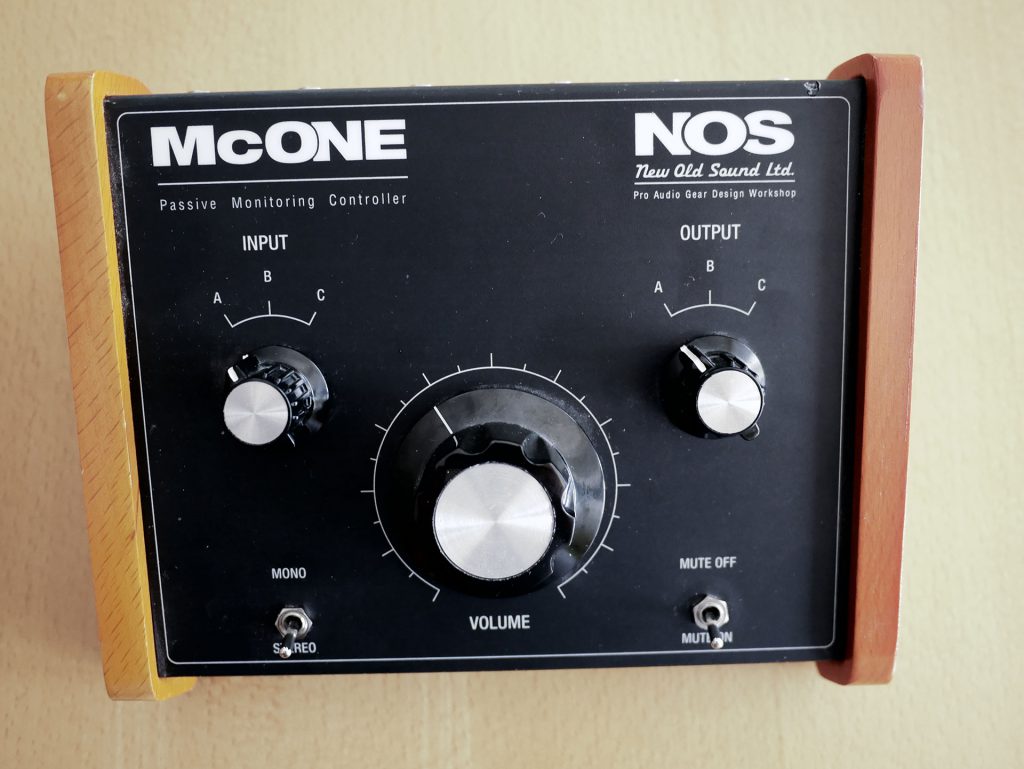The mixing in the home studio takes place in the DAW. The optimum volume control can of course be adjusted there via the master fader. But what happens if you want to connect more than one monitor speaker or if you want to quickly listen to the entire mix in mono? Now, at the latest, you would like to have an analog device that allows you to switch quickly and where you have something in your hands. A so-called monitor controller is ideal for this. Something like the McOne Monitorcontroller.
Active or passive?
For some time now I have been using a passive monitor controller from New Old Sound, namely the McOne (1st generation). At that time I had consciously decided for a passive controller, because I was already more than overloaded and wanted to avoid another potential humming device. I previously had an active monitor controller that tended to hum.
Finishing
The little box comes across very chic. The metal box is framed by two wooden borders. Very noble and very stable. The potentiometers and toggle switches make a very stable impression and are well made, as are the 6 jack sockets on the back of the monitor controller. The lettering is white, which can be read very well on the black metal.

Backside of the McOne Monitorcontroller
There are a total of 12 jack sockets on the back. 3 x 2 sockets each for input and output. But I would have found XLR jacks better. I had and still have (sometimes) difficulties to get real pressure on the speakers. This means that I have to turn up the volume control quite a bit to get enough listening power. I’ve tried some high quality cables and I’m still not 100% happy.
Operation
The large volume control is located in the centre of the control panel. It is rasterized in 20 steps. Whether this is an advantage or a disadvantage, there are many different opinions. Personally, I see it as a big advantage because I can reproduce exactly the same volume over and over again.
In addition to the volume control, there are two other rastered controls, each with three choices. With the left knob you decide which input signal to use and with the right knob the output, e.g. for different monitor pairs.

Clever switch solutions
There are also two toggle switches. With the left toggle switch you can quickly switch between mono and stereo and with the other toggle switch you can mute your setup. Especially the switch function between stereo and mono is a real plus. Just think of all the modern loudspeakers, such as Sonos, Bose… portable speakers.
Sound of the McOne Monitorcontroller
That thing doesn’t matter. And that’s a good thing in this case, because you want to hear the pure sound.
Specifications
- 3 times 2 symetric/asymmetric Jacks Input
- 3 times 2 symmetrical jacks Output
- Passive Monitor Controller
- Dimensions: 19cm x 15 cm x 8 cm (width x depth x height)
- Weight: 1,1 KG
Summary of the McOne Monitorcontroller
Plus
- Very good finishing
- Retro look
- A total of 3 inputs and outputs raster potentiometers
- Stereo/Mono toggle switch
Minus
- Only jack sockets, no XLR connectors
- Sometimes I miss some volume
